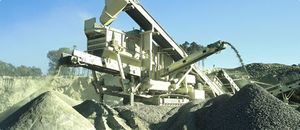Difference between revisions of "Secondary Stage Crushers"
Jump to navigation
Jump to search
| Line 8: | Line 8: | ||
* -------------------------------------------------></noinclude> | * -------------------------------------------------></noinclude> | ||
[[File:Secondary_and_tertiary stage.jpg| thumb | right | Secondary and tertiary Crushing work ]] | [[File:Secondary_and_tertiary stage.jpg| thumb | right | Secondary and tertiary Crushing work ]] | ||
Rock leaving the [[Primary Crushers|primary crusher]] typically is 8 inches in diameter or less. This crushed rock is moved to the '''Secondary Crushers|Secondary Crusher''' to reduce it further in size. or is being crushed by the same crusher which is adjusted to deliver a smaller output material. | |||
Rock leaving the [[Primary | |||
The [[Cone Crushers | Cone Crusher]] is often used in the Secondary stage. in this stage the size control and shape starts to get important. Using a secondary HSI means as always a restriction in feed hardness | The [[Cone Crushers | Cone Crusher]] is often used in the Secondary stage. in this stage the size control and shape starts to get important. Using a secondary HSI means as always a restriction in feed hardness | ||
Revision as of 07:36, 2 February 2012
Rock leaving the primary crusher typically is 8 inches in diameter or less. This crushed rock is moved to the Secondary Crushers|Secondary Crusher to reduce it further in size. or is being crushed by the same crusher which is adjusted to deliver a smaller output material.
The Cone Crusher is often used in the Secondary stage. in this stage the size control and shape starts to get important. Using a secondary HSI means as always a restriction in feed hardness
